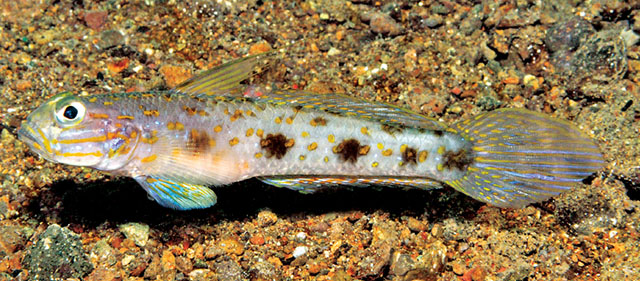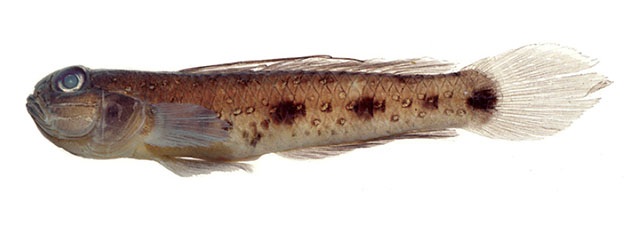Acentrogobius vanderloosi Allen, 2015
Description
This species is distinguished by the following characters: D VI + I,10, dorsal spines thin and flexible, first two with long filamentous tips, that of second spine longest 2.3-3.2 in SL, reaching to base of about sixth soft ray of second dorsal fin when laid back; A I,10; pectoral-fin rays 20; lanceolate caudal fin which is slightly longer than head length in adult; scales 30 in longitudinal series; 9-10 transverse-scales; 12-13 predorsal-scales; finely ctenoid scales cover the body, becoming cycloid on the breast, pectoral-fin base, nape, and head; 3 scale rows on uppermost portion of opercle; cheek fully scaled; colour in life pale grey with numerous widely scattered dark-edged, orange spots on body, 5 horizontally-elongate dark brown blotches on side of body at level of pectoral-fin base, (including one at middle of caudal-fin base), a pair of orange stripes on cheek (Ref. 100513).
Taxonomic Hierarchy
Kingdom: Animalia
Phylum: Chordata
Class: Teleostei
Order: Gobiiformes
Family: Gobiidae
Genus: Acentrogobius
Species: Acentrogobius vanderloosi Allen, 2015
Climate Zone
Location
Biology
The collection area consists of moderately sloped (about 20 degrees) mud substratum (the slope begins in approximately 1.5 m depth and flattens out at about 18 m). The featureless bottom has numerous burrows occupied by a variety of fishes and invertebrates, including Acentrogobius vanderloosi. About eight individuals were observed on the lower section of the slope (15-18 m ) and only widely scattered, solitary individuals were seen, each of which was invariably associated with a muddy burrow, into which it retreated when approached (Ref. 100513).
Habitat
demersal
Conservation Status
Not Evaluated
Threat to Humans
Harmless

